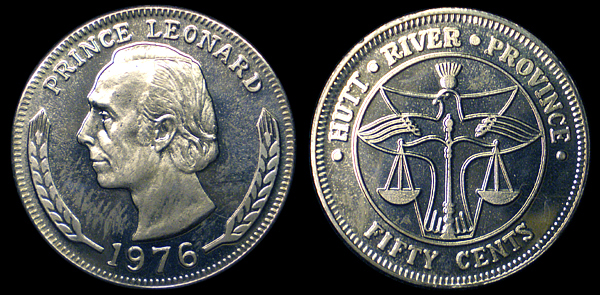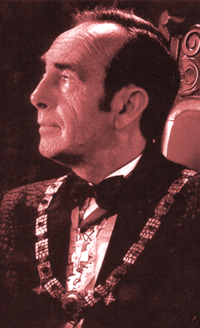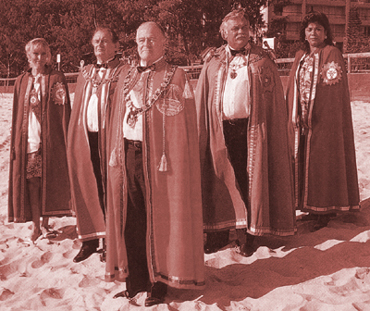
HUTT RIVER PROVENCE (AUSTRALIA) 50 CENTS 1976
X-4 Hutt River Province 50 cent coin depicting Prince Leonard I (micro-nation)
Obverse: Portrait base head left - PRINCE LEONARD 1976
Reverse: HUTT RIVER PROVENCE - 50 CENTS
|
Pictured above is a 50 cent coin issued by the Australian secessionist state of Hutt River Province and its self proclaimed Prince, Leonard I. This coin was issued six years after farmer Leonard George Casey and associates proclaimed their secession from the state of Western Australia. It is part of a series of original issue coinage that is valid currency in the principality. The currency of Hutt River is the Hutt River Dollar which is divided into 100 cents and is valued at a one to one ratio with the Australian dollar. The principality has issued 5, 10, 20 and 50 cent coins as well as 30 and 100 Dollar silver and gold issues. Along with its official coinage it has also issued banknotes, stamps and a large variety of special issue commemoratives in a wide variety of themes. These original issue coins were minted from 1976 to 1978 by the Lombardo Mint in relatively small runs. They were all produced by the designer Christine Norman. Hutt River Province (principality) and HRH Prince Leonard I: The man who would someday become prince was born Leonard George Casey in rugged South-Western Australia around 1925. As a child he attended school and worked odd jobs, as an adult he worked various jobs in the farming and agricultural industry. He married Shirley Butler (Princes Shirley) in 1947 and the two began a family that would eventually include 7 children. His issue in order of age are: Prince Ian (1947), Duchess Kay (1949), Prince Wayne (1950), Duchess Diane (1951), Prince Richard (1953), Prince Graeme (1957) and Duchess Sherryl (1958). Casey acquired an extensive amount of land, about 75 sq km, 595 km north of Perth and 26 miles northwest of Northampton near the town of Gerldton. He moved his extended family onto the land and proceeded to farm its 18,500 acres. In 1968 the government of Western Australia issued wheat quotas. These quotas were a way to avoid the 'Guarantee Price' which states that any surplus wheat is to be bought by the government. To keep from having to pay for large surplus, they restricted the amount of wheat allowed to be brought to market. A grievous blow is reported to have been dealt Casey as his quota was set at 100 acres although he had previously grown up to 13,000 acres and had a thousand acres of wheat ready for harvest and delivery. Casey stated that the revenue from such a small quota would hardly pay the interest on the loan due on his 4 tractors. After learning more about the law as it pertained to quotas and petitioning the government, he was dismayed to find two clauses in the law that seemed unjust. There could be no appeal to the law and there would be no compensation. He states: "I consider that this then cut across all sense of justice, that if injustice was done, there was to be no right of remedy." After his appeals to the government were either ignored or answered with threats to resume his lands, he realized he had few options when facing the government of Australia and the queen whom can only be sued if she allows it. Casey, family, and associates took steps to secede from Australia on April 21, 1970 under the grounds that he was being robbed of his means of support and as protection from threats to strip him of his lands. He and his family proclaimed a 'government of self-preservation' would exist on his extensive land holdings and would be called the Hutt River Province. Well versed in the law and with a keen mind, Casey was initially the administrator of the new province. It seemed apparent that the government would be taking a hostile stance towards the new province so he looked for protection under old treason laws that state royalty are protected from charges of treason. He would, from then on, hold the title of His Royal Highness Princes Leonard I, Sovereign of the Hutt Province with a population of twelve. What real protection from the law this act provided would, in the end, be minimal. Such laws were stricken and new ones introduced but the story of the farmer who stood up against what he saw as injustice, who when met with no other recourse broke away to start his own government, spread quickly. The official position of the Australian government seems to be that his land remains a part of Western Australia, the titles and rhetoric being nothing more than an odd business venture. Some local authorities take a more antagonistic approach and often look to make life as difficult as possible for the principality. All the same, as the prince states 'If anyone asks if our succession succeeded...then we simply say WE ARE STILL HERE". Soon the idea of the principality seemed to over shadowed any dispute with the government of Australia and the matter seemed to settle into a kind of limbo. The Principality created a constitution and set themselves to the task of creating all the conventions of state. The constitution called for a hereditary constitutional monarchy with a council of state and appointed ministers. Laws were enacted and government buildings, a chapel, and a monument to the succession populated Nain, the capitol of the Hutt river province and its only settlement. Coinage was minted, stamps were issued by the post office, and banknotes were printed and sold to people around the world. Interest in the principality on a farm in Western Australia attracted visitors, the principality became a business bringing revenue into the coffers of the new prince and his fledgling nation state. In the 80's the Prince made the acquaintance of a businessman from the state of Queensland by the name of Kevin Gale. By the 90's, Kevin had become Prince Regent Kevin, second only to Leonard and had apparently been given license to market the province. Gale took the concept and ran starting a direct marketing venture to sell a huge number of commemorative coinage issues, stamps, citizenships, and titles among other Hutt River merchandise. The business relationship eventually soured between the two princes. Upon his death in 1995, Kevin was posthumously charged with treason when it was alleged that he had withheld most of the business profits, enriching himself while reportedly plotting to take over the principality. The 15 year business partnership ended with each side claiming to have been wronged. Leonard claiming to have been betrayed while supporters of Kevin claiming defamation and misrepresentation of the facts. Hutt River lives on and the business of empire continues to this day. The principality still sells stamps and banknotes and has again offered new issues of coinage. The Principality celebrated its 30th anniversary in 2000 and the name was officially change to the Hutt River Principality in 2006. Although the principality has fewer than 30 actual residents, it claims as many as 13,000 citizens worldwide with official representatives in many different nations. To date no nation has recognized Hutt River as a Sovereign nation His son Ian George Casey (Prince Ian) is his designated sucessor.
|


